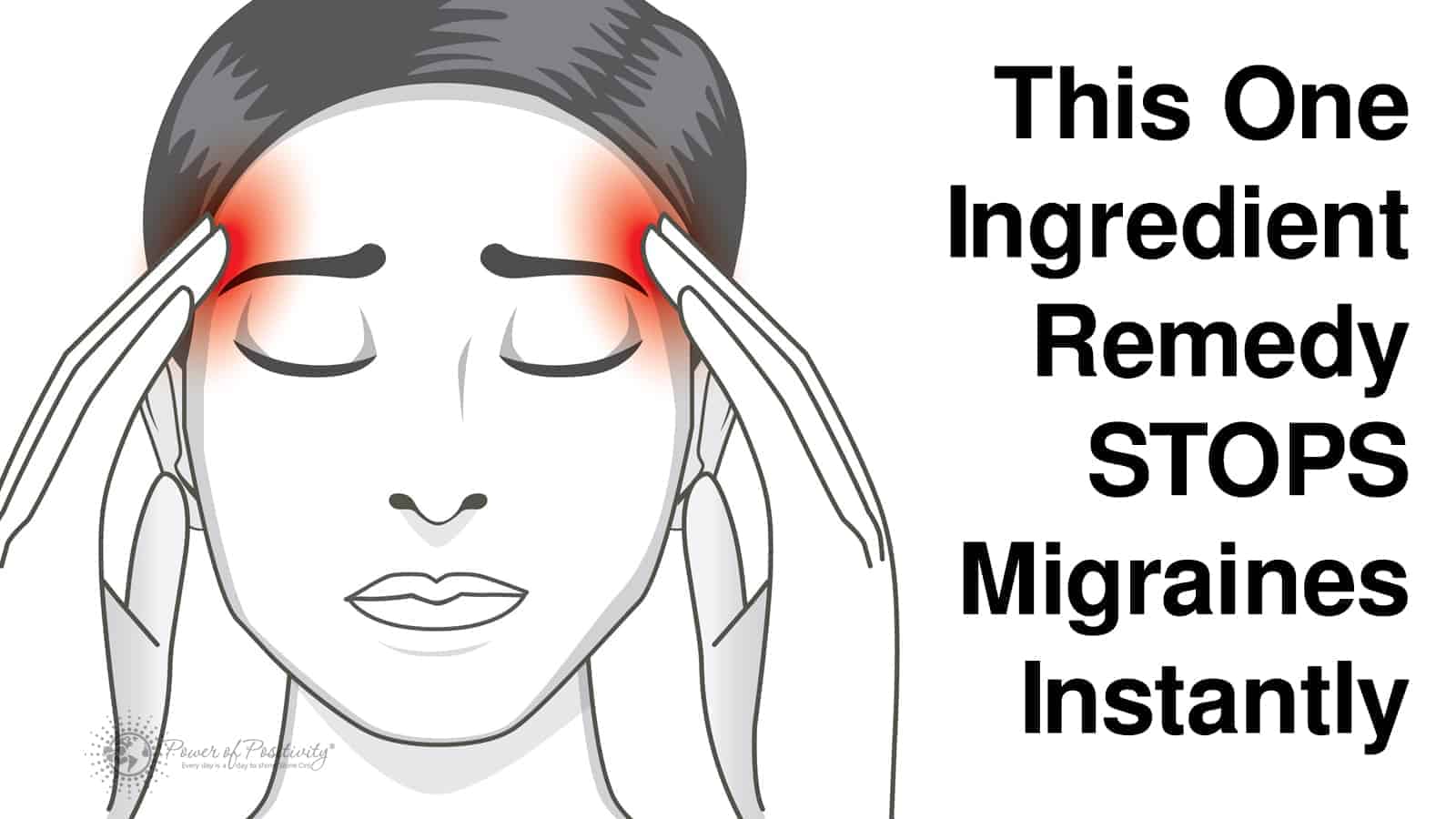If you’ve ever had a migraine, you know that the pain can be excruciating, and you would do anything to make it stop. Although traditional medicine offers migraine relief, other home remedies exist. So you might not believe how easily this one natural ingredient might relieve your migraine pain.
According to the Migraine Trust, 54% of sufferers experience one or more attacks per month, and 13% claim one or more episodes per week. As a result of migraines, an estimated 25 million days are lost from work or school because of migraine worldwide. The World Health Organization classifies severe attacks as the most disabling illnesses, comparable to dementia, quadriplegia, and active psychosis.
Migraine sufferers know that it’s not like a usual headache. The severity of the pain and the duration typically set a migraine apart from a regular headache.
If you are unsure what type of head pain you are experiencing, you can read more on this topic here. Consult your doctor for help if the pain does not subside with over-the-counter medication or home remedies.
What Happens During a Migraine?
Inside your head, blood flows in a circle like a halo, providing oxygen to all of your brain tissue. Neurons are firing, and all of your bodily functions are controlled by the computer that is your brain.
When it happens, two things are causing you pain. First, blood vessels dilate. They open up, and more blood than usually starts flowing to your brain. The pressure on the blood vessels of the increased blood flow is one cause of your pain.
The second cause of pain, according to the Migraine Relief Center, is that “cranial vessels leak, causing swelling in the area.”

Indeed, it’s no wonder you feel pressure in your brain when you have this headache. These headaches can last from 4 to 72 hours. During that painful time frame, some people feel nausea to such an extreme as to cause vomiting. Often, people experiencing one need to lie down and rest to recover until the pain subsides.
Some people will also experience visual hallucinations during a migraine, like tiny lights appearing or tunnel vision where their field of vision is closed off. This experience is common, but it can make any normal activities like driving impossible until it passes.
What Causes a Migraine?
They can come from an environmental triggers such as red wine, stress, sustained loud noise, dehydration, soy products, or even weather pressure changes. Sufferers quickly learn to look for and avoid the possible triggers that brought on the migraine.
Women have a higher incidence of migraines due to hormonal changes. Women sometimes find that they are more likely to experience a migraine during the same time of their monthly menstruation cycle. Other hormonal changes like pregnancy or menopause can bring on a change in migraine frequency.
Over the Counter Migraine Remedies
The Migraine Trust says that “migraines remain undiagnosed and undertreated in at least 50% of patients, and less than 50% of migraine patients consult a physician.” Most try to fix the pain by taking their usual pain relievers such as ibuprofen, aspirin, or acetaminophen.
Both aspirin and ibuprofen act to thin the blood, and they will have a negligible effect on migraine by reducing the pressure on blood vessels in the brain. The time it takes for these to impact is excruciating for the person suffering from the headache.
Prescription medications are also available from a doctor in pill, patch, injection, or nasal inhalant forms. For oral medication, migraine sufferers take them at the first sign of symptoms. Other forms might be faster acting or in the path form. Thus, they deliver a steady dose of medication to help prevent migraines.
This ONE Natural Ingredient Can Stop A Migraine Instantly
The one miracle cure for your migraine? A drop of high-quality essential frankincense oil placed on the pad of your thumb then pressed into the roof of your mouth is a natural remedy that can stop migraines instantly.
Ancient Egyptians used frankincense oil as a natural migraine remedy when applied externally to the head. Some people report disliking the taste of the oil, so they use it in specific massage points on their heads. Put the oil on your fingertips and rub your temples, forehead, back of your neck, and scalp.
One study found that the monoterpenes in Frankincense and other essential oils act as a potent anti-inflammatory. This reduces the swelling of the blood vessels and reduces the pain. A second study showed that frankincense oil reduced the intensity and frequency of headaches in patients who experienced debilitating cluster migraines.
If you are one person for whom the frankincense oil does not work, try something to constrict your blood vessels, such as applying cold. A wrapped ice pack applied to the back of the neck or even running cold water over your head should help reduce the size of your blood vessels. Holding some cold water in your mouth while breathing through your nose will also help.
10 Additional Ways You Can Benefit from Using Frankincense Oil (Besides Treating Migraines)
Frankincense oil can do much more than alleviate a migraine. Here are some other fantastic uses for this essential oil.
1. Reduces inflammation
Chronic inflammation may cause a migraine, but it can also lead to different diseases, such as these:
- Cancer
- Type 2 diabetes
- Rheumatoid arthritis
- Heart disease
- Hay fever
- Periodontitis
- Arterial disease
Inflammation is your body’s way of trying to protect itself from injury. Inflammation happens when your body gets rid of cell or tissue damage from an injury. Frankincense contains boswellic acid, which helps your body to calm down. Applying Frankincense to the injured area can reduce inflammation that causes swelling, redness, and warmth in the injured area. Be sure to mix the Frankincense with a carrier oil to maximize its benefits.
2. Heals wounds
Besides stopping a migraine headache, Frankincense has antibacterial properties to heal wounds on your skin. It regenerates skin tissue, opens your pores to remove toxins, and prevents infection. Some suggest that Frankincense reduces age spots and can even out your skin tone. You can use Frankincense topically by mixing two to four drops with coconut oil or shea butter. Rub it directly on your skin.
3. Antifungal treatment
This fantastic oil also has antifungal properties. It can kill some types of fungal yeast. You must always dilute Frankincense in a carrier oil such as:
- Almond oil
- Argan oil
- Coconut oil
- Grapeseed oil
- Jojoba oil
- Rosehip oil
To get rid of toenail fungus, follow these directions. Clean your toenails with soap and water. Dry them off with a towel. Apply a couple of drops of Frankincense mixed with a carrier oil. Let the oil soak into your toenail for fifteen minutes. Then scrub your toenail with a nail brush. Do this treatment once a day for several months, noticing the fungus disappearing.

4. Kills some cancer cells
Melanoma is a very aggressive form of skin cancer. It metastasizes quickly, and once it’s in this state, it’s hard to cure. There are 132,000 new cases of melanoma diagnosed in the world each year. In 2019, one study found that Frankincense essential oils suppress melanoma cancer in mice.
5. Helps treat asthma
Frankincense oil helps improve the symptoms of bronchitis and asthma. Those who use Frankincense report fewer episodes of asthma symptoms of wheezing, shortness of breath. This aromatic essential oil calms your respiratory tract so that you can breathe easier. Put a few drops of Frankincense on a cloth and inhale the scent for a few seconds. Or you can use an oil diffuser to fill a room with the smell of Frankincense to help you breathe easier.
What is a diffuser?
Diffusers come in all shapes and sizes. They’re prevalent today for releasing essential oil scents into the air. These electric devices spread essential oils of your choice throughout a room in your home or car. A good diffuser will include these things:
- Easy to clean
- It has a timer to allow for the right amount of time to diffuse the oil
- Should run for at least an hour
- Will disperse fragrance into a room in less than thirty minutes
Don’t diffuse your essential oils for too long since they may irritate your nose, skin, or eyes.
6. Faster recovery from a cold
If you have a cold, Frankincense can speed up your recovery. It breaks up the phlegm in your lungs and opens your respiratory tract. Frankincense’s anti-inflammatory benefits help you get rid of your migraine. That’s because it can reduce the swelling in your nasal passages so you can breathe better. If you’re suffering from a cold, use a diffuser with some Frankincense oil to improve your breathing and faster recovery from a cold.
7. Reduces anxiety
Another tremendous benefit of Frankincense essential oil is its ability to reduce your anxiety. Breathing in this aromatic oil calms you almost immediately. Like how Frankincense stops a migraine, this essential oil reduces stress and improves your mood. You can apply Frankincense oil to the bottoms of your feet to enhance relaxation. Try using it every morning to boost a positive attitude as you face the day.
8. Gut health
Another helpful benefit of Frankincense is reducing gut bloating and pain from conditions like
- Irritable bowel disease (IBS)
- Ulcerative colitis
- Constipation
- Stomach cramps
People who took Frankincense once a day for four weeks had a significant decrease in stomach symptoms of pain and cramping. Researchers hope to learn more about the healing properties of Frankincense related to gut health.
9. Skincare
People swear by Frankincense’s skincare benefits. This essential oil acts as an astringent, bringing balance to your skin’s oil production. It works as a toner that tightens and strengthens your skin’s elasticity. Frankincense provides a natural barrier against bacteria that causes blemishes.
Plus, when you use this essential oil, you’ll notice your skin is softer. Be sure to mix it with an appropriate carrier oil for the skin, such as jojoba oil or coconut oil. Many feel it’s a natural anti-aging remedy and smooths out pigment discolorations.
10. Improves oral hygiene
Frankincense may prevent gum disease and improve your overall oral health. Its potent antibacterial properties fight gum disease infections. In the Far Eastern parts of the world, Frankincense is a traditional medicine used to fight cavities and other mouth-related infections. Researchers are studying other therapeutic benefits for oral hygiene of this fantastic therapy.
Final Thoughts on Frankincense Oil for Migraine Relief
If you suffer from migraines, you understand how debilitating they can be. When you have a migraine, you need to hit the pause button on your life. Blinding pain makes it impossible to function at work, home, or school. Prescription medications can relieve the pain, but they have some dangerous side effects. Frankincense’s natural ability to stop a migraine is a God-send for sufferers.
This essential oil’s ability to reduce inflammation and swelling can end your migraine in short order. Put one or two drops of Frankincense on your thumb, and then press your thumb into the roof of your mouth. Quickly, you’ll notice your migraine fading away. If you are unconvinced of Frankincense’s effectiveness, why not try it the next time you get a migraine?





















